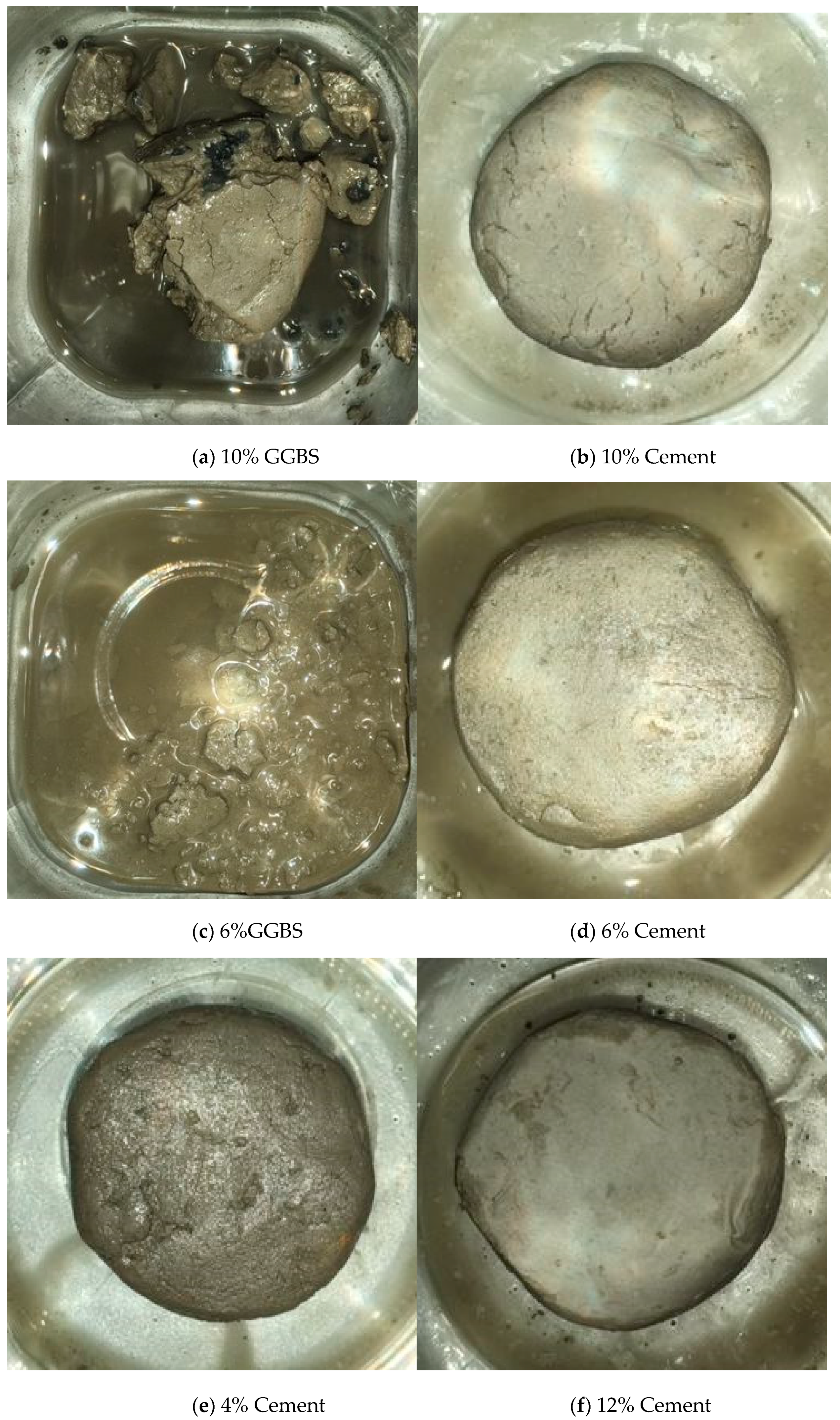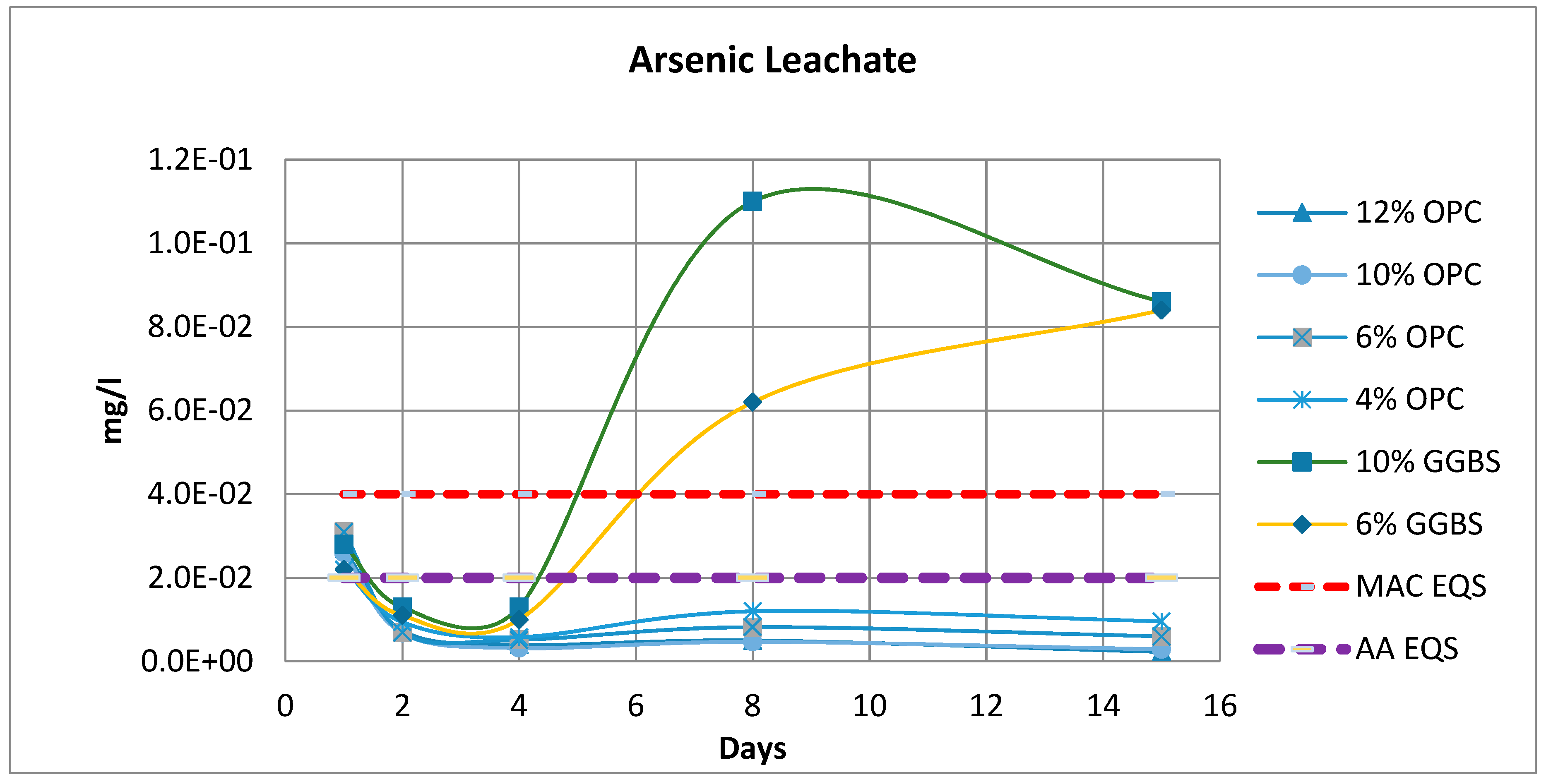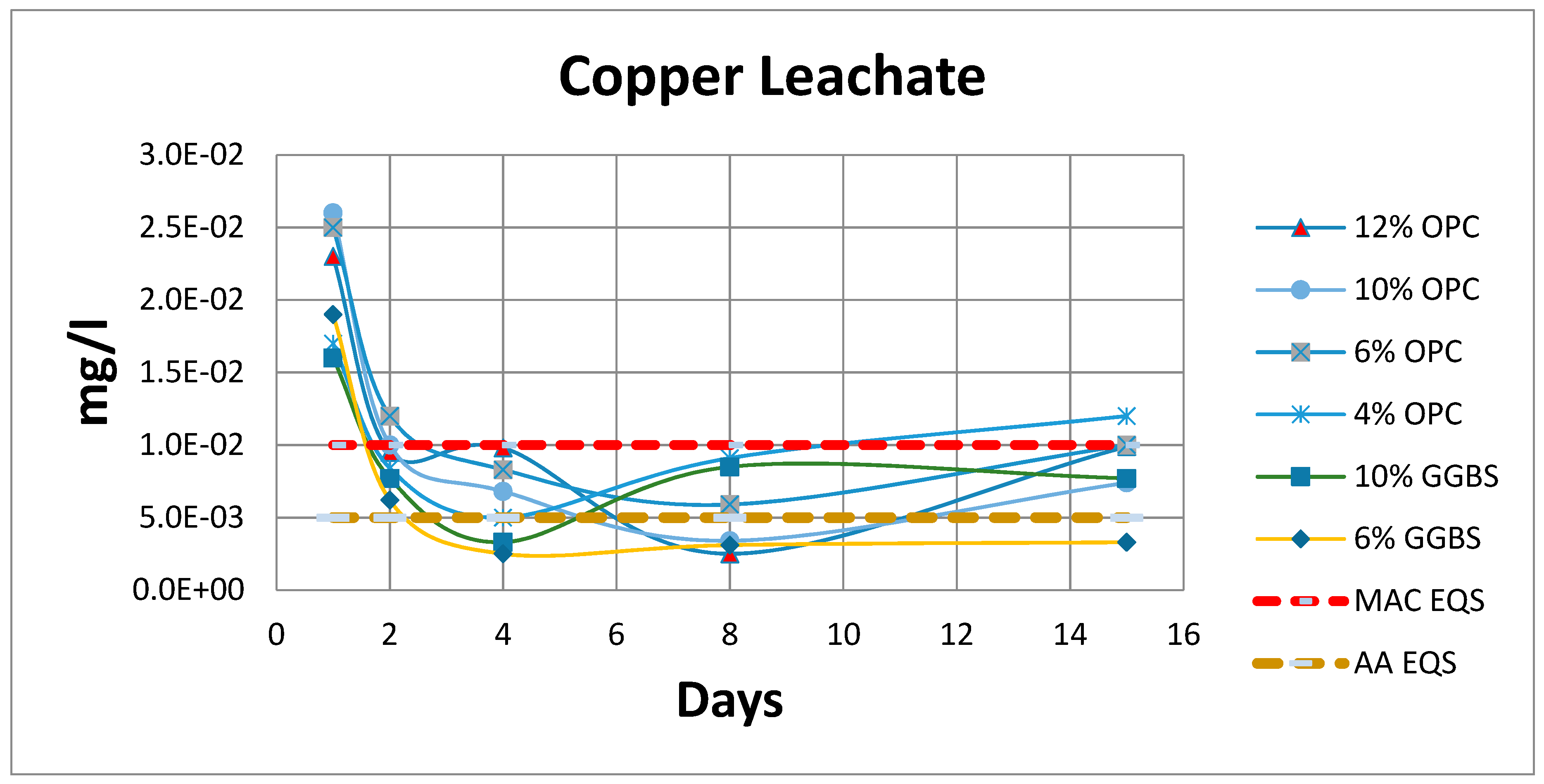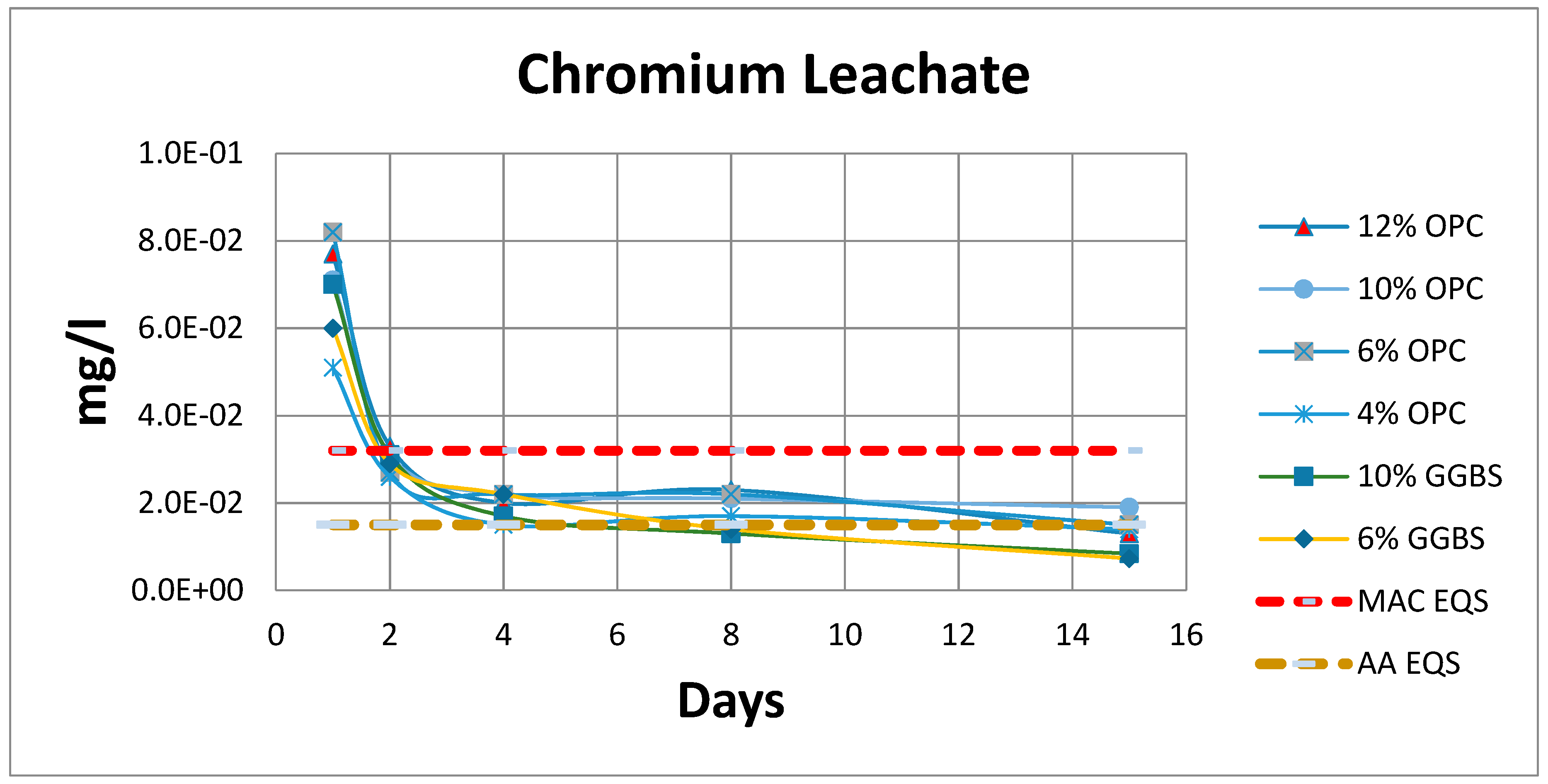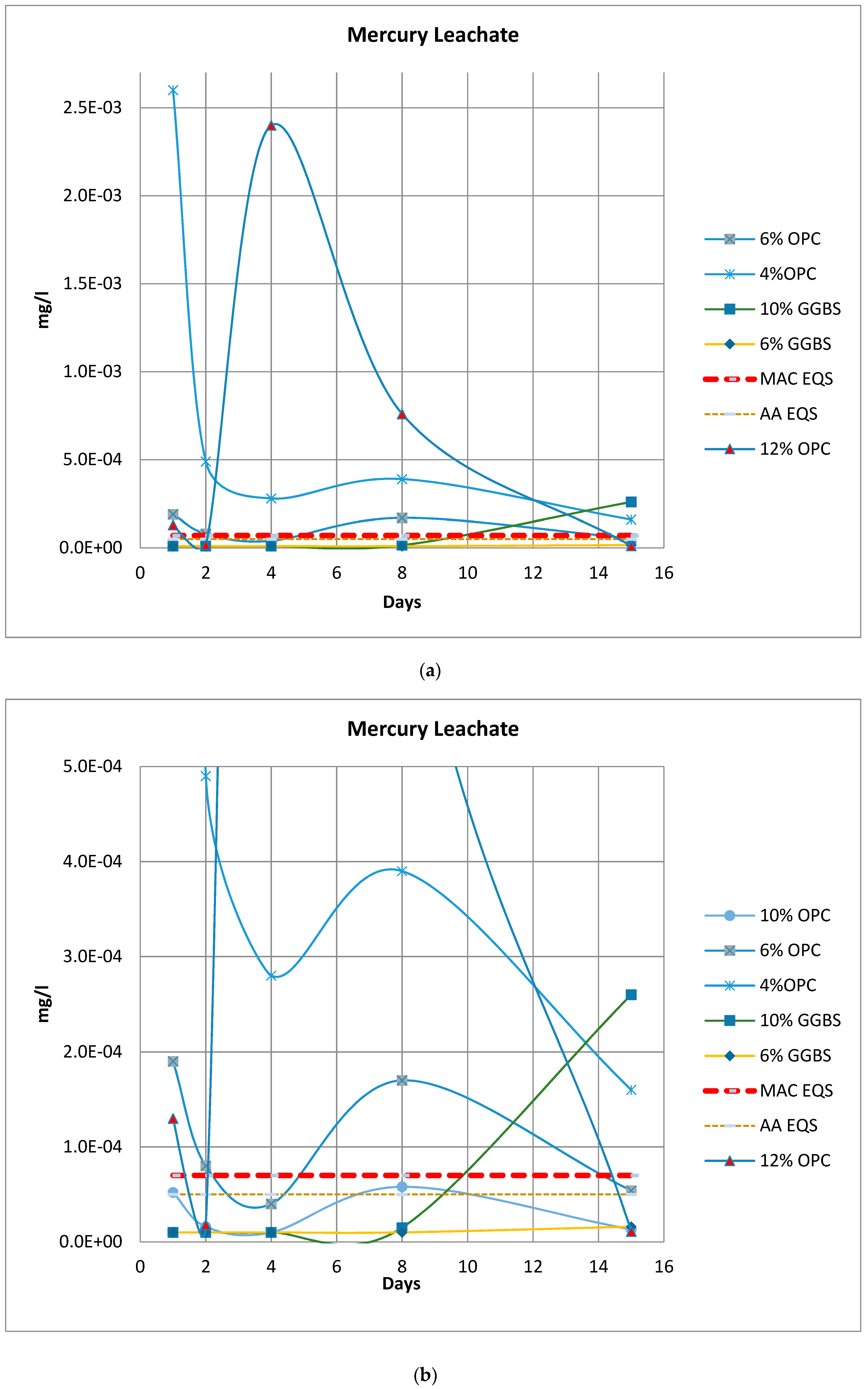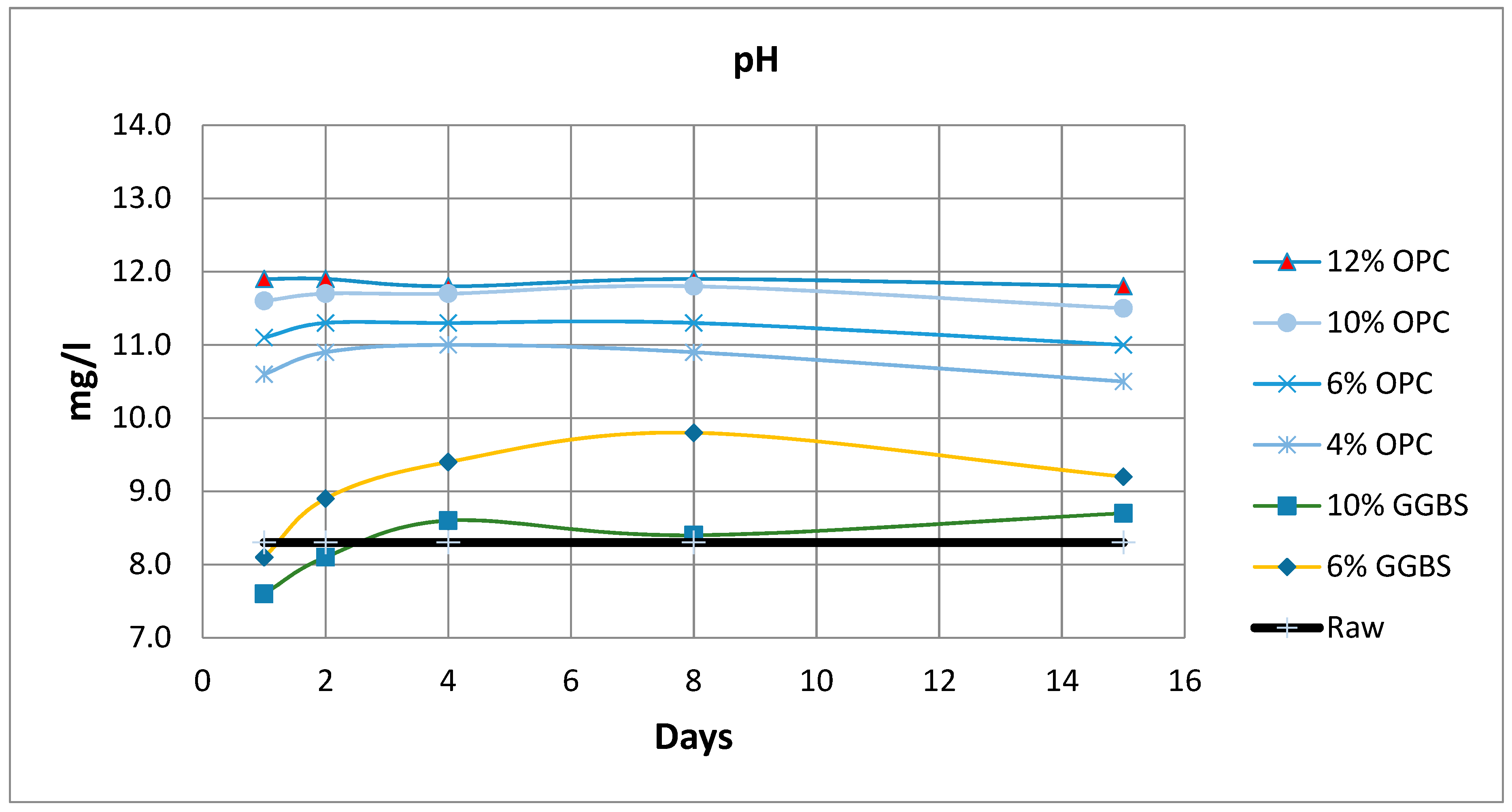1. Introduction
There is a dual benefit to mixing cementitious binders with contaminated dredge material. The effective contaminant binding and increased engineering properties transforms an otherwise costly waste into a valuable construction material. The trialling of this approach has been well documented in heavily contaminated marine projects [
1] where the cost benefit of solidification and stabilization (S/S) has been justified by the expensive alternatives to disposing of heavily contaminated hazardous waste, >€ 200/m
3 [
2]. Another alternative is contaminated soil remediation methods ranging from Electro- chemical separation, thermal treatment, bio remediation and sediment washing. Each of these approaches has its own niche applications and drawbacks but the focus of this study is on S/S, which has been established as a suitable method for the remediation of hazardous dredge material. However, as the contamination level decreases, the cost viability of disposal to landfill and also other remediation techniques is not as prohibitive. This raises the question of how cost effective S/S can become on projects where off-site disposal while not environmentally desirable is a potentially competitive alternative. Present costs for S/S vary from approximately € 30/m
3 to € 100/m
3, including dredging. A significant driver of the variation of costs of S/S on contaminated soil is the quantity of the binder required. The focus of this study is to quantify the effectiveness of low levels of binder in achieving satisfactory remediation of contaminants and acquiring the characteristics of a usable engineered material.
S/S has been used on a variety of contaminated soils and is not limited to dredge material. The treatment of sewage sludge was undertaken with ordinary Portland cement (OPC) to stabilise the sludge for use in the construction industry [
3] The binder percentages ranged from 50% to 75%. In New Jersey S/S was utilised to treat 17,000 m
3 of contaminated material from a former wood treatment facility. A binder mix of 8% OPC was utilised to treat material that was contaminated with arsenic, chromium and polycyclic aromatic hydrocarbons (PAHs) ([
4]. In situ S/S was implemented in the remediation of a manufactured gas plant (MPG) in Massachusetts, USA, [
5] that was contaminated with non-aqueous phase liquid (NAPL). The binder consisted of a 7%, by weight, cement to soil ratio and was injected into the soil using an auger head. Approximately 80,000 m
3 of soil was remediated using this system.
In terms of contaminated dredge material, one of the largest projects was undertaken by the New York Port Authority who stabilised 2,300,000 m
3 of dredge material contaminated with heavy metals, dioxins and polychlorinated biphenyls (PCBs) using an 8% OPC mix. This material was subsequently utilised as engineering fill [
6]. The binder recipe chosen to stabilise heavy contaminated dredge material at the Port of Gävle, Sweden, had three binder components, cement, GBBS and fly ash. A total amount of 150 kg/m
3 of binder was used to stabilise heavily contaminated material with a low bulk density of 1100 kg/m
3 (13.6% by weight) [
7]. The leachate from the contaminated material showed high levels of zinc (Zn), mercury (Hg), chromium (Cr), copper (Cu), cadmium (Cd), lead (Pb) and arsenic (As). Analysis of the leachate from stabilised material indicated no specific trends other than the higher binder content and the greater reduction in contaminated leachate. A mix of fly ash and rapid cement was used as the binder in the mass stabilisation of 12,000 m
3 of dredge material contaminated with high levels of zinc (Zn) in Port Kokkola [
8]. The binder percentage varied with moisture content. An average of between 8% and 9% binder by weight was utilised to achieve contaminant mobility reduction. In Bantry Harbour, Ireland, a range of OPC binders, from 4% to 12% OPC by weight, were trialled on mildly contaminated dredge material [
9]. It was found, through chemical analysis of leachate on the various mixes, that the 8% binder recipe was the most effective in terms of immobilising contaminants while ensuring economic viability of the project. A planned S/S project in Alexandra Basin, Dublin Port, Ireland, for hazardous dredge included bench scale tests of a range of composite binders including fly ash, OPC and ground granulated blast furnace slag (GGBS), all mixed to raw material with 18% binder recipes. Recently, a study comparing a range of OPC mixes and combined GGBS/OPC mixes as dredge material binders was undertaken [
10]. The trial examined the unconfined compressive strength (UCS) and pore water retention capability of different mixes; however, direct leachate testing of contaminants was not undertaken. The trial found that a mix ratio of up to 6% GGBS with 6% OPC improved the water retention of the material.
The solidification of dredge material for strength improvement purposes with a variety of binders, including OPC, lime and fly ash, was undertaken at percentages of 3%, 6% and 9% binder by weight mixed with Dunkirk dredge sediments [
11]. The 9% cement mix provided the largest increase in UCS with an improvement from 0.5 MPa to 3 MPa. The acceptability of soils in engineering works, from an Irish perspective [
12], is based on the interpretation of BS5930 [
13]) and an analysis of case studies. In summary, soils with strength less than 40 kPa are unacceptably weak, soils with strength less than 50 kPa are considered acceptable for short term stability, and materials with strength of 75 kPa or more are generally considered acceptable for earthworks in construction projects. Soils in the range of 40 kPa to 75 kPa are considered firm, however, their use is dependent on site factors such as the type of plant and the experience of the contractor.
A review of previous S/S studies and projects indicates that lower bound binders, in percent by weight, of contaminated dredge material seem to be in the range of 8–9%, even for non-hazardous contaminated sites. Another feature of the S/S projects is that the use of complex multi-component binder recipes adds complexity to the S/S process in terms of the post treatment performance analysis and, also, the construction process implementation. These multi-component mixes require separate silos, additional mixing stages and more management time, which adds cost to projects. However, it is also recognised that the complexity of marine contaminated sites can require more than one type of binder to achieve the necessary contaminant containment. The objective of the current study was to examine the effectiveness of two different single-component binders at low binder percentages to rationalise the implementation of S/S on mildly contaminated dredge material. To this end, low percentages of OPC and GGBS were mixed with mildly contaminated material and assessed for performance both in terms of strength and contaminant binding.
3. Test Setup
A composite sample from the proposed dredge pocket was selected for the monolithic tank test [
17]. Four sediment sub samples were mixed with OPC at concentrations of 4%, 6%, 10% and 12% and two were mixed with ground granulated blast furnace slag (GGBS) at concentrations of 6% and 10%. The properties of OPC and GGBS (supplied by ECOCEM) are presented in
Table 2 along with the chemical compositions given by Müllauer et al. [
18]. All mixes were mixed by percentage weight, as shown in
Table 3. We chose two percentages of GGBS because binders of less than 6% GGBS are not considered due to their lack of binding properties. GGBS mixes above 10% were not considered either. As OPC performs well above 10%, as shown in the literature, and is typically slightly cheaper than GGBS, improved performance at higher GGBS percentages would not be attractive from a construction or economic viewpoint, which is the focus of this study.
The samples were mixed with binder without additional water to represent industry S/S practise. The raw materials had a high moisture content, >60%, negating the need for additional water during the mixing process. The samples were then cured for 24 h prior to the test. This was done to represent realistic construction conditions where the dredge material is treated and placed within a 24 h period. The monoliths were moulded as 5 cm diameter and 5 cm high cylinders with a surface area of 118 cm2. During the test they were immersed in 500 mL of water; this water was changed at 1, 2, 4, 8 and 15 days and the eluent was tested for a suite of metals, benzene, toluene, ethylbenzene and xylene (BTEX) and total petroleum hydrocarbon (TPH).
In addition to the leachate testing three OPC trial mixes were tested for undrained shear strength. This was undertaken to identify the required binder mix that would achieve the necessary engineering characteristics for reuse as structural fill. Mixes of 8%, 10% and 12% OPC, by weight, were tested at 7, 24 and 280 days. The other binder mixes were not tested after the initial inspection.
4. Results
The structure of the monoliths at the end of the tank testing,
Figure 1, highlighted the unsuitability of a pure GGBS binder mix as an engineering fill material. Both the 10% and 6% monoliths showed signs of significant degradation when compared to the equivalent OPC% binder mixes. The four OPC mixed monoliths displayed various levels of structural integrity post-immersion, as is borne out by the results of the strength testing discussed below.
A comparison of concentrations of the total concentrations (mg/kg) and the WAC soil concentrations (mg/kg) to the concentrations of the constituent concentrations of the binders (from
Table 2) are presented in
Table 4. The partition coefficients of each contaminant are also presented to provide an indication of the relative ability of each contaminant to bind to a particular sample matrix.
It should be noted that due to the nature of the raw dredged material there was some variability in the contaminant concentrations in each monolith. In addition, the monolith tests were designed to assess the diffusion of the contaminants across a surface; as the structure of the GGBS samples failed during the test it is likely that the amount of leaching from the GGBS samples was affected.
Time–series graphs of the leachate concentrations and the relevant EQS values (where available) for each of the contaminants is presented in
Table 1 and arsenic, chromium, copper, mercury and zinc are presented in
Figure 2,
Figure 3,
Figure 4,
Figure 5 and
Figure 6. The time–series chart for the pH of the eluent is presented in
Figure 7.
The OPC mixes had a definitive reducing effect on the leachate of the arsenic in the material,
Figure 2. The major reduction occurred within the first 24 h of mixing for all four mixes of OPC with only a minimal difference in the performance from the 12% to the 4% mixture. The GGBS mixes displayed a more complex relationship, where leaching of arsenic as an initial reduction similar to the OPC in the first 24–48 h was followed by a marked increase in leaching, peaking at Day 8 for the 10% mix at 1.1 × 10
−1 mg/L and with 6% GGBS displaying a continuous increase with 8.5 × 10
−2 mg/L leaching on Day 15. The behaviour of arsenic in GGBS binders is complex with levels of arsenic leachate peaking at almost three times the MAC EQS limit. This represents increased leaching compared with the leachate from the raw samples.
As shown in
Table 4, the concentration of arsenic was highest in GGBS (approximately seven times higher than the OPC concentrations) such that the concentration in the GGBS material was most likely higher than the dredged material used in the sample. The variation between the concentrations of arsenic in the OPC and GGBS samples was expected to be influenced by a combination of a higher proportion of arsenic and a poor sorption to the matrix for the GGBS samples. It is likely that this was exacerbated further by deterioration in the GGBS sample structure.
The copper leachate concentrations indicate that the 6% GGBS was the most effective binder for this contaminant type. It was the only binder recipe that reduced the leachate below the AA EQS limit for up to 15 days post mixing. The 10% GGBS showed a small peak at Day 8 with a reduction in leachate until Day 15. All the OPC mixes showed an initial reduction in copper concentrations but a gradual increase resulting in values over or close to the MAC EQS level at Day 15.
Copper had a high partition coefficient so it sorped strongly to the sample matrix. The OPC contained approximately three times more copper than GGBS and approximately twice that of the raw dredged material; hence, it was likely the higher concentrations of copper in the OPC samples that masked the reduction in leaching from the OPC samples, due to the higher sorption when compared to the GGBS samples.
All mixes performed well in reducing chromium concentrations; however, the rate of reduction of the GGBS mixes slightly outperformed that of the OPC mixes. The 12% and 4% OPC mixes and the 6% and 10% GGBS mixes were all below the AA EQS at the 15 day interval.
The partition coefficient for chromium was the highest, by a significant margin, of the contaminants considered here. The impact of this, seen as a variation in the concentrations between samples, was lower, indicating high sorption to the matrix for all the samples considering the concentrations of chromium in GGBS were higher than that of both the OPC and the dredged material.
The nature of the effect of binders on mercury within the dredged material was more complex with the 12% and 4% OPC mixes, displaying much higher levels of leachate than the other mixes, (
Figure 5a). These mixes displayed elevated levels of mercury leachate; the magnitude was notably greater during the first 8 days of testing with a reduction thereafter. The 12% mix had levels substantially lower than the AA EQS by Day 15. Conversely the 10% GGBS mix displayed elevated mercury leachate concentrations after Day 8, resulting in significantly elevated mercury leachate levels by Day 15, (
Figure 5b). The 6% GGBS and 10% OPC performed best in relation to reducing mercury leachate over the 15 day testing period.
We considered the high mercury concentrations observed for the 4% and 12% OPC samples to have derived from variations in the contamination of the dredged material. As mercury is soluble in water any localised pockets of contamination would dissolve during the monolith sample preparation and, thus, would the peak concentrations at Day 1 and Day 4 for the 4% OPC samples. The 10% OPC samples could have derived from the aqueous mercury concentrations held in the sample’s pore water.
While the raw leachate concentrations indicated that zinc was not an issue,
Figure 6 showed the general trend of low levels of zinc. The OPC mixes had a common trend in leachate reduction over time while the GGBS mixes showed an initial reduction followed by a significant increase at and after Day 8. This was useful for designing a mix with zinc contamination, a common issue in port sediments. The OPC appeared to be the more suitable in terms of contamination remediation.
Zinc concentrations were significantly higher in OPC than both GGBS and the raw dredged material (
Table 4). In addition, zinc had a lower propensity to sorb to the sample matrix compared to coper and chromium; this is due to its lower partition coefficient. As with copper, the ability of OPC to bind to the concentrations in the dredged materials was being masked by the elevated zinc concentrations in the OPC samples.
The variation in pH was also recorded for each of the six binder mixes,
Figure 7. The OPC had the effect of raising the pH significantly with the 12% OPC binder mix having the most elevated pH, approximately 12, of all of the mixes tested. Conversely, the pH of the GGBS mixes was reduced as the percentage of GGBS binder increased; as the pH for the 6% sample exceeded the pH of the raw dredged material the 10% GGBS sample decreased. It is likely that this was due to variations in the pH of the dredged material used in the 10% GGBS sample rather than the increase in the GGBS binder.
Strength Testing:
The OPC binder mixes were tested for undrained shear strength, 12%, 10% and 8% following standard guidance [
19], to assess their acceptability in terms of reuse as an engineering fill. The density and moisture content were measured prior to strength testing,
Table 5, and, as expected, the density increased with an increase in the percentage of OPC binder.
The 8% OPC mix yielded soft sediment with an undrained shear strength of 21 kPa to 24 kPa,
Figure 8. There was no notable increase in strength between Day 7 and Day 280. The 10% OPC binder mix yielded ‘soft to firm’ sediment with an undrained shear strength increasing from 29 kPa on Day 7 to 46 kPa on Day 280. Firm sediment was achieved with the addition of 12% OPC to the dredge material, even at the 7 day mark, with a 15% increase in strength, on Day 280, to 68 kPa. These results suggest that only the 12% OPC mix produced an engineered fill material with the necessary strength properties to be of use as a structural fill material.
5. Discussion
When assessing the suitability of the various mixes both the reduction effect on contaminant leachate and the improved engineering characteristics of the material have to be considered. The testing of the mixes in this study indicated that a range of options are available depending on the desired outcome. The higher OPC based binders (10–12%) produced a material with acceptable engineering strength and strong contaminant confinement of the typical heavy metals found in harbour sediments, in this case arsenic, chromium and zinc, with mercury leachate showing signs of reduction after Day 8. However, the mixes with high OPC contents performed poorly in terms of elevated pH and copper leachate restriction. There was also the economic drawback of using a relatively high ratio of binder. The lower OPC mixes (4% and 6%), while economically desirable due to the lower amounts of cement required per unit weight of dredge material, generally performed poorer than the GGBS or higher OPC binder mixes. From the strength test results of the 8% OPC mix, it can also be concluded that the strength improvement of these lower binder percentage mixes will not increase their engineering properties sufficiently for them to become an acceptable fill material in general construction projects.
The performance of the GGBS mixes was more varied than that of the OPC mixes. Both of the GGBS mixes performed poorly in terms of composition, as shown by the photographs in
Figure 1. The lack of structural integrity of the monoliths suggests that the GGBS mixes tested would not be suitable for reuse as any type of engineered fill material, which immediately reduces its value compared to the OPC mixes. The binders also performed poorly in terms of limiting the leachate from arsenic and zinc and the 10% GGBS showed a significant rise in mercury leachate from Day 8 to Day 15. The 6% GGBS mix performed the best of all on mercury, chromium and copper leachate reduction, however.
The performance of the GGBS mixes in relation to arsenic and zinc was most notable. The increase in arsenic in this study was contrary to recent work [
20], where the leaching of arsenic was shown to decrease, relative to pH, when GGBS was tested on aggregates in combination with flyash and OPC binder. That work showed a relatively similar leachate level of arsenic for a mix of 10% flyash/90% GGBS compared with a 100% OPC binder content at 350 kg/m
3. The poor performance, in relation to arsenic leachate retention, recorded in the present study could be a function of the structural integrity of monolith, or lack thereof, due to using GGBS as the sole cementitious binder component. However, as shown in
Table 4 there is almost seven times the amount of arsenic in GGBS than OPC in its raw state, which is also a contributory factor. The poor performance of GGBS binder in relation to zinc was peculiar due to the fact that there was more than 10 times the amount of zinc in OPC than in GGBS in its natural state. Zinc released from the GGBS/flyash mix was shown to be the same as an OPC binder when mixing granular aggregates, [
20]. However, the results for both arsenic and zinc could indicate that the contaminants sorb more strongly to the matrix in the OPC samples.
The varied results of the mixes for reducing mercury leachate indicates a need for further testing to investigate whether the observed high concentrations for the 4% and 10% OPC samples originated from variation in the mercury concentrations of the dredged material.
